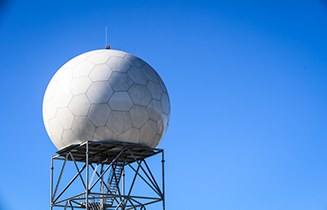Published May 4, 2019
A little more than a week after an EF3 tornado, packing winds of 136-165 mph, struck
in the early morning hours of April 25, Ruston remains a city torn asunder by the
force of nature.
ULM's Doppler weather radar
The National Weather Service credits the University of Louisiana Monroe’s Doppler
radar system as vital in helping save untold lives. The data from ULM’s Doppler radar
was crucial to the alerts, alarms and sirens informing residents that a tornado was
on the ground.
Prior to February 2017, the NWS may not have been able to provide adequate warning because
there was a large gap in radar coverage.
ULM installed its Doppler radar system in October 2016. “We have been providing the
National Weather Service offices in Shreveport and Jackson with a direct feed of our
data since February 2017,” said Todd Murphy, an Assistant Professor of Atmospheric Science
at ULM.
Through a dedicated server, the system delivers NWS-Shreveport meteorologists up-to-the-minute
information that they use as a major tool in tracking dangerous weather.
“Before our Doppler radar, we relied on the weather service’s radar in Shreveport
and Jackson. But because of the curvature of the Earth, those radar systems were overshooting
Northeast Louisiana,” Murphy said.
On the night of April 24, the NWS-Shreveport was tracking a storm system that included
several reports of tornado damage along a 150-mile stretch beginning in St. Augustine
County, Texas.
The storm moved northeast, taking aim at Ruston.
Monroe is closer to Ruston than Shreveport is, “so we were able to provide a lower
radar beam” given the Earth’s curvature and the storm’s close proximity to the ground,
Murphy said. That beam told quite a story.
The ULM radar captured a debris signature with the storm that the Shreveport radar
failed to detect.
“Shreveport saw circulation and a tornado debris signature” in the data transmitted
from the ULM system, Murphy said, explaining that a debris signature, when picked
up by radar, is an indication that material is flying in the air and a tornado is
on the ground. “It gave Shreveport more confidence in what they were seeing.”
The NWS-Shreveport meteorologists, using the ULM data, then checked with their other
resources.
“Usually, the weather service uses an array of reports -- police, spotters and radar,” Murphy said
Jason Hansford, the meteorologist on duty in Shreveport in the early morning of April
25, in correspondence with Murphy, explained how ULM’s radar “depicted a tightening
circulation just southwest of Ruston along U.S. 80 around 1:45 a.m., with what appeared
to be a debris signature which was confirmed by our damage survey team as the preliminary
start point of the tornado.
“The debris signature was quite apparent around 1:52 a.m. near the intersection of
U.S. 167 and I-20, which I noticed and immediately told the warning meteorologist
on the Ruston storm to issue a follow-up (statement) confirming a radar-indicated
tornado. I also had our communicator call the Ruston PD/Lincoln Parish Sheriff's Office
to alert them of the radar confirmed tornado, which they confirmed themselves from
the ground given the substantial damage reports coming in,” Hansford wrote.
The NWS-Shreveport used all of the available data to redraw its warning boxes. It
also provided Ruston residents with time. Tornado-warning sirens wailed and urgent
statements came in a steady stream through weather radios.
“The data from this radar, alongside the spotter call, and frequent communication
with the Bienville/Lincoln, and Union Parish Sheriff's offices during the event, was
extremely beneficial and helped our office save so many lives during this event,”
Hansford wrote.
“In fact, our office and the survey teams received numerous compliments from the public,
city, parish and state officials with the long lead times leading up to the impacts
on the city of Ruston.”
Without ULM’s radar, the National Weather Service would not have had a complete picture
of what was happening on the ground in Ruston when, as Hansford writes, “this destructive
tornado struck the city shortly before 2 a.m. when much of the city was sleeping.”
The warnings could not save property. Louisiana Tech suffered heavy damage, especially
to the softball and soccer stadiums. Several homes and businesses were reduced to
rubble.
Huge trees were uprooted and tragically, a mother and son were killed when a tree
fell on their home.
But ULM’s role in the tornado detection and the saving of lives cannot be underestimated.
“The ULM radar is becoming an indispensable tool as part of our warning operations
for north central Louisiana and the surrounding areas,” said Mario D. Valverde, meteorologist
in charge at the National Weather Service office in Shreveport.

